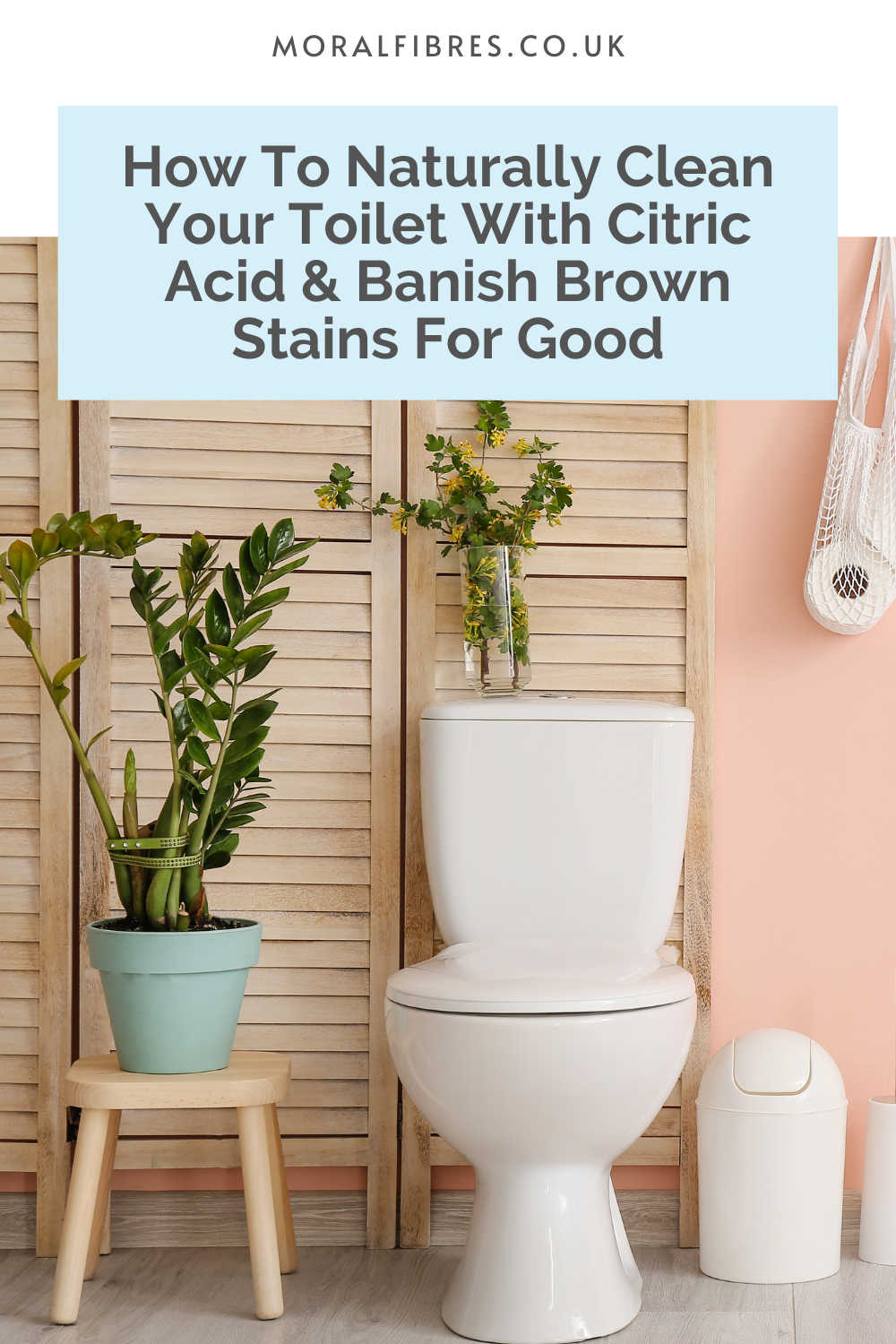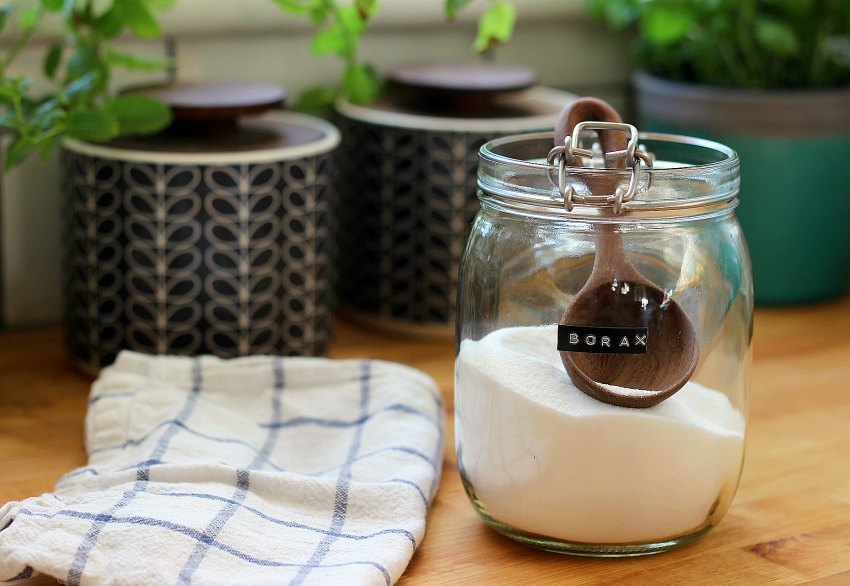How To Clean Your Toilet With Citric Acid Effectively
To support the running costs of Moral Fibres, this post may contain affiliate links. This means Moral Fibres may earn a small commission, at no extra cost to readers, on items purchased through these links.
Does your toilet have brown stains that will not shift? Worry not, here’s how to clean your toilet with citric acid to naturally remove these stains without scrubbing.
Limescale is the bane of my life. This hardened build-up of minerals starts off looking a bit grey. It’s a bit unsightly but you figure you can live with it. It sets like cement, after all, and no amount of scrubbing with a toilet brush will shift it. But then it turns a horrible brown colour, and your toilet looks absolutely filthy even though you clean it frequently.
Reassuringly, that brown colour isn’t dirt. It’s simply mineral deposits in the toilet. This includes minerals such as iron, calcium, magnesium and lime which slowly turn the limescale brown. Still, it’s unsightly as anything and no doubt you’re going to want to remove it.
Before you bust out the bleach, know that bleach doesn’t remove limescale. All it does is bleach it white, so it is harder to see. For a really clean toilet, you want to remove that limescale.
How To Remove Brown Stains From Your Toilet

So how do you remove brown stains from your toilet naturally and effectively?
I’ve heard of all sorts of wild ways that people have tried to remove brown limescale deposits. From people emptying cans of Coca-Cola down their loo, and cans of WD40. Then you’ve got people scrubbing their toilets with pumice stones or sandpaper. And then there’s the wildest way of them all – using screwdrivers or chisels!
It seems that short of replacing their loo, people will go to almost any length and effort to get rid of these unsightly brown marks.
If only these people knew that you can quickly, cheaply, and easily remove brown stains and limescale deposits from your toilet with citric acid.
It’s true. To remove limescale from your toilet, simply add some citric acid to your toilet, wait a few hours, and give it a little scrub with a toilet brush for a gleaming finish.
What Is Citric Acid?
Citric acid is a naturally occurring acid that is particularly found in lemons and limes. I wouldn’t recommend using lemon to clean limescale from your toilet though. This is because citric acid is much more concentrated than lemon or lime juice.
In fact, lemons contain just 1.44 grams of citric acid per ounce of juice. You’d need to use A LOT of lemons to get the same cleaning power as a small amount of citric acid.
As a naturally occurring acid, citric acid contains no harsh chemical compounds or fumes that can be hazardous to your health or the environment. It is safe for use in natural cleaning applications. It is also readily biodegradable in waterways and elsewhere in the environment. And citric acid is safe for use in septic tanks too.
In saying that, do see my tips below on using citric acid safely as there are safety considerations you should make when using citric acid.
As well as in natural cleaning, citric acid is also commonly used in the food industry. It’s a common ingredient in both beer brewing and winemaking. It’s used as a preservative, to increase the shelf life of pre-packaged foods. And it’s even used as a food additive to add natural flavour to certain foods.
Citric acid generally comes in the form of a white powder. It’s easily found in stores and online – here’s my full guide on where to buy citric acid for cleaning.
How To Clean Your Toilet With Citric Acid

To shift those stubborn brown stains and clean your toilet naturally, grab a box of citric acid and get cleaning. Thankfully, there’s no chiselling involved!
Here’s the full how-to:
- Pour a full kettle of hot water down the toilet bowl. The water should not be boiling hot as it could crack your toilet. If that happens then you’ve got a bigger problem than just brown stains on your loo!
- Add around 125 grams of citric acid to your toilet bowl. It doesn’t have to be an exact amount, so don’t worry about weighing it out.
- Leave the citric acid in the toilet bowl, without flushing, for at least one hour. My preferred method is to add the citric acid at night, just before I go to bed, so it can soak off the limescale overnight.
- After leaving the solution to soak, flush the toilet, and use your regular toilet cleaner and a toilet brush to scrub at any remaining limescale deposits. These should come away easily without too much effort.
- If your toilet is particularly stained, then it may need a second application to remove stubborn limescale deposits.
How Citric Acid Works To Clean Your Toilet Effectively
This method works to clean your toilet, because of a few key points. Firstly, the heat of the hot water helps to loosen the limescale.
Secondly, when it comes to chemical reactions in science, generally, higher temperatures mean faster reaction rates. In this case, the hot water means the citric acid reacts faster with the limescale. You might even see or hear fizzing in the toilet bowl when you add the citric acid. This is a sign of the citric acid reacting with the alkaline limescale.
If you don’t hear or see any fizzing, then don’t worry. This is not a sign that the citric acid is not working. It may just mean that the citric acid is reacting a little more slowly with the limescale. The limescale will still come off after a good soaking or two.
And for the science part, limescale is otherwise known as calcium carbonate. When calcium carbonate reacts with citric acid, it breaks down to form calcium citrate. This is a soluble salt that is easy to wash away. No sandpapering required!
Safety First
Whilst citric acid seems like a fairly benign substance, there are some safety considerations that you need to make.
Firstly, and very importantly, never mix citric acid with bleach. Doing so releases toxic gases that can be very harmful to your health.
And whilst citric acid is considered a natural cleaning product, it can still have some adverse effects if not handled properly. As a concentrated acid, it can irritate your airways, eyes, and skin. As such you should avoid breathing in any citric acid powder, and wear rubber gloves when handling it. Don’t rub your eyes after handling citric acid, and keep the powder away from children and pets.
You can read more about citric acid, and the dos and don’ts for cleaning with it, in my guide to cleaning with citric acid.
Don’t want to use citric acid? Try my guide to the best eco-friendly toilet cleaners.
And looking for more natural cleaning inspiration? I believe that natural cleaning products, such as citric acid, can be as effective, if not more effective than commercial cleaning products. As such, I’ve got over 25 natural cleaning products to DIY and tons of advice on green cleaning.
Found this post useful? Please consider buying me a virtual coffee to help support the site’s running costs.




